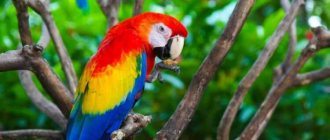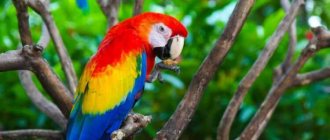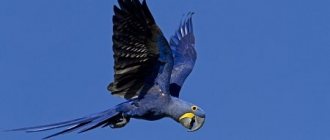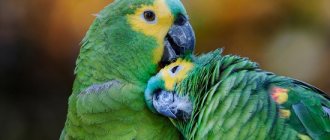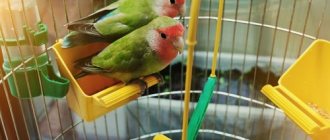Fans of exotic birds especially appreciate the small, cute Corella parrot with a crest on its head. It is known to breeders as a “nymph”. The delicate beauty, humility, and intelligence of the fragile bird allowed her to take a place among the most popular pets. The article describes the features of the Australian parrot: habitat, lifestyle, reproduction, habits. The details of appearance are considered and the main colors are listed.
Appearance of a cockatiel
The color of the plumage varies depending on the gender of the birds. The main color of the female's feathers is gray. The lower part is darker, and the head and crest are light with a yellowish tint. Females have brown spots on their cheeks. Males are brighter, their body is dark gray in color. The crest and head of the male are yellow, the front part and cheeks have a gray tint. They have orange spots on their cheeks. The plumage of the tail and wings is black with a blue tint. These birds have a short beak.
An adult cockatiel reaches 30-33 cm in length, with a tail length of 15-16 cm. These birds weigh about 90 grams.
Corella (Nymphicus hollandicus).
Corella Parrot Habitat
These cute birds are found almost throughout Australia, with the exception of very dry areas and the eastern part of the mainland, where rainforests are located. It is also impossible to meet these birds close to the shore. In appearance, these birds are somewhat similar to cockatoos, but cockatiels have a longer tail and look more elegant. Just like cockatoos, these birds have a crest, the feathers of which fall and rise depending on the mood of the bird.
The cockatiel is a bird of the cockatoo family and the only species of its genus.
An interesting feature: cockatiels do not have a layer in their plumage that is responsible for structural coloring, so the color of the feathers is determined solely by pigments. Caring for these birds is much easier than for larger members of the family. Corellas can be kept not only in enclosures, but also at home.
Keeping cockatiels
For a long time, cockatiels were not popular as pets; they were overshadowed by the glory of budgerigars, although the maintenance of these birds is very similar. And only when a variety of mutations, and therefore colors, of cockatiels appeared, they began to gain popularity as ornamental birds.
Throughout the year, with the exception of the breeding season, they stay in small groups.
Compared to cockatoos, these birds cause less damage and are practically not prone to destruction. This makes it possible to keep them in the simplest enclosures, consisting of a wooden frame and metal mesh. Corellas can live in a flock. They can be placed with budgies - they get along well.
Another advantage of these birds over parrots is their quieter and more melodic trill; these birds sing with a whistle, but this will not cause discomfort to your neighbors - they will not hear your pet’s trill. Cockatiels have perfectly adapted to living in residential buildings and are able to live there happily ever after. Birds experience affection for their owners, which is unusual for most larger birds.
One look at these birds is enough to determine the sex of the bird: males have a lemon-yellow head and orange spots in the ear area. The body of the bird is mostly gray. Part of the wing is white, and the tail feathers are almost black. The female's head is gray above and has a yellow wavy pattern below. Young males are similar in appearance to adult females. The exceptions are the cere, which is not gray in color (in females), but pink, and the length of the tail feathers - they are shorter in young males.
You can also recognize a young male by the trill he makes, and this can be done even before he reaches 6 months of age, when he changes his plumage to “adult”.
Lifestyle in freedom
Alba's lifestyle is sedentary. They live in pairs that form small flocks (maximum of 50 individuals). A formed group of birds lives on the same tree for many years. Sometimes, when there is a shortage of food, they can steal people's agricultural crops.
Despite well-developed wings, they do not like to fly. Among the preferences of crested animals are climbing treetops and moving by jumping. If flocks of other species of parrots fly past Kakadu Alba, they actively scream, greeting their relatives. Particularly friendly to Yellow-crested Cockatoos. But if strangers try to take a place on the branches of their “dwelling,” they loudly knock on the crown with sticks.
The main food is papaya or durian fruits, nuts, plant seeds, small bugs and their larvae. During the breeding season, they prefer high-protein food - mosquitoes, beetles, small lizards.
Types of cockatiels
Cockatiel feather color variations are limited and fewer than other parrots. This is due to the structural features of their plumage. Some states, in particular the USA, have their own exhibition standards for these birds. All species of these birds are the same in their ability to imitate speech and tameability.
Australian law does not allow cockatiels to be exported overseas.
Major diseases of the White-crested Cockatoo
The most common diseases in Alba parrots: self-plucking, physical trauma, sacrocystosis, fatty hepatosis, obesity, infections of bacterial or fungal origin, food intoxication, cloacal prolapse, ornithosis.
At the slightest suspicion of illness, the parrot needs to be shown to a veterinarian.
Prevention of many of the above-mentioned diseases is the proper care of the bird’s home.
Recommended:
- clean the feeders and drinkers daily and wash them well;
- washing poles and toys as they become dirty (if they lose functionality or are damaged, replace them with new ones);
- washing the cage once every 7 days, followed by ongoing disinfection;
- complete disinfection of the parrot’s housing and equipment once a year.
Video: Cockatoo Parrot Panic
Variegated cockatiels
This variety was bred in 1949 in California. Interestingly, even within a subspecies there may be differences. The main color of the plumage is gray, with pale yellow spots. Some members of this species have completely pink legs, including the claws.
Cockatiels are quickly tamed and can learn individual words as well as melodies.
Cockatiel breeders prefer birds that are completely symmetrical in coloration, including the placement of spots, but it is impossible to predict what kind of chicks even carefully selected individuals will have.
Brown cockatiels
This species gets its name due to its color – these birds’ main color is not gray, but brown. This mutation appeared in 1950 in New Zealand. These cockatiels were bred in artificial conditions - in enclosures, but there is information that among the representatives of the wild form living in Australia, birds with brown plumage were seen.
Several color variations of cockatiels have been bred - pure white, pearl, variegated and others.
Like lutino cockatiels, color in cinnamon cockatiels is directly related to gender. As they grow up, males acquire a darker color compared to females.
Crowned heads
The crest of the Inca cockatoo parrot grows up to 18 cm. This decoration has white and red-yellow feathers. Their arrangement on the bird's head is reminiscent of the festive dress of the South American Indians and looks like a crown turned sideways.
The Inca lives in the south and west of the mainland. Prefers an arid climate, but settles near lakes and rivers. The seeds of low-growing eucalyptus, acacia and pine, figs, melons, pecans and almonds, flowers and grain are eaten. They fly poorly, but cover long distances to search for food.
A pair of parrots created for breeding jealously guards their own territory, the size of which reaches 500 hectares . They are kept at home only in Australia and only with the consent of the authorities. The birds are protected and are not imported to Europe. They have been replaced almost everywhere by pink cockatoos.
Pearly cockatiel
In this species, the mutation affected the distribution of plumage color pigment. The center of the feather remains pale, and the edges become darker due to the melanin concentrated there. As they mature, this contrast in color in males disappears, since during this period melanin is redistributed to those areas where there is a lack of it - to the center.
The lifespan of birds is up to 20-25 years.
Not long ago, a subspecies of these birds appeared, in which the color of the males does not change throughout their lives. Thanks to this, it became possible to cross this variety with other, both lighter and darker species and obtain new mutations, including pearlescent cinnamon and pearlescent lutino cockatiels.
Cockatiel nutrition
Typically, these birds consume one and a half tablespoons of feed per day. Breeders must ensure that the birds do not overeat, this is detrimental to their health. The maximum permissible daily food intake is two tablespoons. You should give your cockatiels fruits and vegetables to meet their needs for minerals, vitamins and trace elements.
Cockatiels are skilled at begging for pieces of food and opening locks while no one is looking.
Lovebirds
Lovebirds are called love birds because of the extraordinary mutual affection between the male and female. In nature, this species of birds can be found in Africa and on the island of Madagascar.
The male and female are always together. Even if one of them flies away, he tries to be within such limits that he can hear the sounds of the other half’s voice. Lovebirds do everything together: they get food, fly to water, rest, picking each other’s feathers. They are agile and dexterous and can fly quickly.
These birds feed on berries and small seeds.
How to determine the age and sex of a bird
Females and males, adults and young are similar in appearance, so it is quite difficult to immediately determine the age and sex of a feathered pet. The easiest way to determine age is with classic gray cockatiels. In this species, adult individuals are slightly larger in size than young offspring. The growth of these birds occurs before the first molt.
Cockatiels sincerely express their dissatisfaction with creepy, ear-piercing, unpleasant screams.
Adults have darker feet and beaks. Juveniles can boast a straighter crest compared to adult birds. It is most difficult to determine the sex of white cockatiels; outwardly, the birds practically do not differ from each other and therefore it is impossible to visually distinguish a female from a male.
Reproduction
The white cockatoo parrot mates for life. The parrot's breeding season lasts from December to March. To build a nest, the couple chooses a tall tree with a deep hollow; it will become their permanent habitat for many years.
The female lays no more than 3 eggs once a year, and both parents hatch them. After about 30 days, the chicks appear; they fledge only after 2 months. The chicks begin to fly out of the nest at the age of three months, but for another month they are looked after and fed by their parents. At the age of five, the white cockatoo parrot can already bear offspring and retains this ability until the age of 30.
